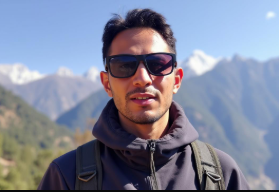Manaslu and Annapurna Trek
Trip Type
Trekking In Nepal
Accomodation
Tea House
Destination
Nepal
Start Point
Kathmandu
Region
Annapurna Region
Duration
21 Days
21 Days Manaslu and Annapurna Trek is a long duration and iconic trek of two destinations Manaslu and Annapurna. This trek covers the Manaslu and Annapurna conservation area. It offers diverse culture, landscapes, and high altitude passes like Larkya La (5016 m) and Thoring La (5416 m). This trek is the ideal package for those seeking a comprehensive Himalayan experience.
Seasonal Information:
The weather varies according to the season in the Annapurna region that influences the experience of trekkers.During spring season (March-May), the temperature is moderate, you get to see clear skies, with vibrant rhododendron blooms. You can see the clear mountain views with less snowfall in high passes. Likewise in Autumn season(September-November), which is the most popular for trekking that offers stable weather and excellent visibility. Also the temperatures at day time are comfortable compared to night one. Due to dry weather you can easily cross the passes. For Winter Season(December-February), the region suffers cold temperature, primarily at higher altitudes and snow may cover some of the trails which makes it more challenging for trekkers.lastly for Monsoon(June-August), rainfall can make trails slippery and risky.Despite that the rich greenery gives the unique perspective to the region.
Cultural and Natural Insights:
From cultural aspects, the route passes through villages in Manaslu region like Samagaon, Lho and Samdo. You can see monasteries, prayer flags, and Mani walls which are common along the route. In the Annapurna trail you can explore the culture of Gurung, Magar, and Thakalis and their local foods and their warm hospitality. This circuit passes through villages like Pisang, Manang and Muktinath. You can experience the spiritual energy in the Muktinath temple which is a sacred place of Hindu and Buddisht. From natural aspects, Manaslu conservation Area is the home for species like snow leopards, Himalayan Tahr, blue sheep, and unique alpine flora. Likewise, Annapurna offers you the diverse landscapes ranging from subtropical forest to arid high altitude deserts. This trek offers the stunning views of mountains like Manaslu(8163 m), Annapurna(8091 m), Dhaulagiri(8167 m) and other himalayas.
Preparation Guide:
A travel essential list ensures safety and comfort throughout the trek. For clothing you need moisture wicking base layers, insulated jackets, waterproof jackets and pants, trekking pants and shirts, thermal innerwear, warm hat, gloves, and scarfs, sturdy waterproof trekking boots.For Gear you need trekking poles, sleeping bag, backpack, headlamp with extra batteries, sunglasses with UV protection, water bottles or hydration bladder, water purification tablets. Also you need essentials like sunscreen and lip balm, snacks and energy bar, map and a guide book, lightweight towel, cash for teahouses and local expenses and personal first aid kits.
Sustainability and Responsibility:
The ecosystem of Everest region has been significantly impacted by increasing tourism. Trekkers have some responsibilities towards the environment to preserve the beauty of the Himalayas for our own good and for the future generation. Here are some ways to practice environmental responsibility:
-
You can carry garbage bags with you or dispose of trash in designated areas.
-
Avoid using single use plastic water bottles.
-
Choose accommodation that follows sustainable practice.
-
You can purchase local goods to uplift/ support the local economy.
-
Avoid picking rare plants that take long to grow and respect wildlife and their habitat.
-
Travel in groups to reduce ecological strain.
Modern Trekkers Expectations:
Now trekkers seek balance between adventure and the outside world while in trek to be connected. Here are some expectation of modern traveller that we try to meet:
-
Internet access as wifi is available at Kagbeni, Jomson, and Muktinath.
-
Comfortable accommodation due to upgraded hygiene facilities.
-
Available expanded menu of options including pizza, pancakes, and vegetarian dishes.
-
You can enjoy thakali sets, momos, and apple pies for food.
-
Sustainable and ethical practices as sustainable practice of waste management and using renewable energy.
-
The trek is through remote valleys and high altitude passes.
Highlights of the Manaslu and Annapurna Trek
-
You can experience the wilderness of Manaslu and diverse landscapes of Annapurna region.
-
You get to cross the highest passes like Larkya La Pass and Thorong La Pass.
-
You can explore the villages, moanstries and diverse culture of Annapurna region.
-
You get to visit the sacred Muktinath temple of both Hindus and Buddhists.
-
You can encounter wildlife species in both conservation areas.
-
You can witness the towering peaks of Annapurna, Manaslu, Dhaulagiri and other himalayas.
Short Itinerary ( 21 days )
You arrive in the International Airport and transfer to a hotel and stay overnight.
You’ll have a scenic drive from Kathmandu to Macha Khola through hills, rivers, and terraced farms. Distance: 160 km, altitude loss: 500 m
You’ll start your trek to Jagat walking through forests, suspension bridges, waterfalls and villages. Distance: 22km, walking hours: 6-7 hrs, altitude gain: 510 m
Now you enter the Manaslu Conservation Area.You get to explore Buddhists prayer flags, stone cravings. Once you reach Deng, stay overnight at a tea house. Distance: 20km, walking hours: 6-7 hrs, altitude gain: 394 m
You’ll start your trek to Manrung. You get to see the view of Shringi Himal. The route passed through dense forests, Tibetan influenced villages. Distance: 19km, walking hours: 6-7, altitude gain: 826 m.
During the trek you can see the first clear view of mount Manaslu. Once you reach Samagaon, you can visit Ribung monastery. Distance: 17km, walking hours: 6-7, altitude gain: 900 m.
It is the rest day for you or you can do a short hike to Pungyen Gompa or Manaslu Base Camp. You can see the stunning glacier views. Altitude gain: 400 m(if hike).
After a whole acclimatization, you’ll trek to Samdo, once you reach Samdo you can see the yak herding settlement, and explore the culture of people living in Samdo village. Distance: 16km, walking hours: 4-5, altitude gain: 345 m.
You’ll trek to Larkya Phedi passing through alpine forest. Once you reach Larkya Phedi, be prepared for Larkya La Pass. Distance: 14km, walking hours: 4-5, altitude gain: 585m.
You’ll cross the high altitude pass Larkya La Pass and witness the panoramic views of Himlung Himal, Annapurna II, Kang Guru. and descend from Larkya to Bimtang. Once you reach Bimtang, stay overnight at a teahouse. Distance: 24km, walking hours: 8-9, altitude gain: 646 m(La Pass), altitude loss: 1386 m.
You’ll descend to Dharapani, crossing lush forests, and rivers. You’ll re-enter the lower region. Distance: 22km, walking hours: 7-8, altitude loss: 1757 m.
You’ll start your trek to Chame. Now you have joined the annapurna circuit. You can see waterfalls, and apple orchards. Distance: 15km , walking hours: 5-6, altitude gain: 747 m.
You’ll start your trek and pass through pine forest and george. You can witness the views of Manaslu and Annapurna II. Pisang offers the traditional Tibetan culture and stunning views. Distance: 10km, walking hours: 5-6, altitude gain: 630 m
You’ll continue trekking to Manang which is a village with stunning mountain views and when you reach Manang it will be the acclimatization day for you to prevent from altitude sickness. You can explore monasteries in the village. Distance: 14km, walking hours: 5-6, altitude gain: 240 m
You’ll rest for the day to prevent altitude sickness. You can hike to Ice Lake and explore Braga Monastery. Altitude gain: 1081 m(if hiking).
It is an acclimatization day so you’ll have a short hike to Yak Kharka. You can enjoy the views of Annapurna II and Gangapurna mountains. Stay overnight at a tea house. Distance: 10km, walking hours: 4-5, altitude gain: 490 m
A short trek to Thorong Phedi which is the last stop before crossing Thorong La Pass. Distance: 6km, walking hours: 3-4, altitude gain: 420m
You’ll cross the Thorong La Pass. After that you’ll trek to Muktinath all the way down. Stay overnight at a tea house in the Muktinath area. Distance: 18km, walking hours: 8-10, altitude loss: 1706 m(from Thorong La Pass)
A short trek to Jomsom and enjoy the apple pies, cider as it is the capital of apples. Distance: 14km, walking hours: 5-6, altitude loss: 1080 m.
You’ll take a scenic aerial flight to Pokhara. And after reaching Pokhara again you’ll take a 25 minutes flight to Kathmandu. Stay overnight at a hotel.
You’ll transfer to the International Airport concluding your journey.
Cost Includes
-
Cost of permits and paperwork
-
Transportation cost
-
Accommodation
-
Meals and Drinks
-
Cost of trekking staff
-
Miscellaneous cost like government tax and service
Cost Excludes
-
Personal expenses
-
Trekking gear and equipment
-
Insurance and emergency cost
-
Tips for guide or porter
Trip FAQS
More Trip Informations
Why Choose Nepal Outdoor Expeditions?
At Nepal Outdoor Expeditions, we see trekking as more than just a hike, it's a journey filled with unforgettable memories, cultural connection, and awe-inspiring scenery. Our dedicated team takes care of everything behind the scenes, ensuring your trip is seamless, safe, and deeply rewarding. Whether you're new to the trails or returning for another Himalayan adventure, we’re here to turn your travel dreams into lasting experiences.


.png)

